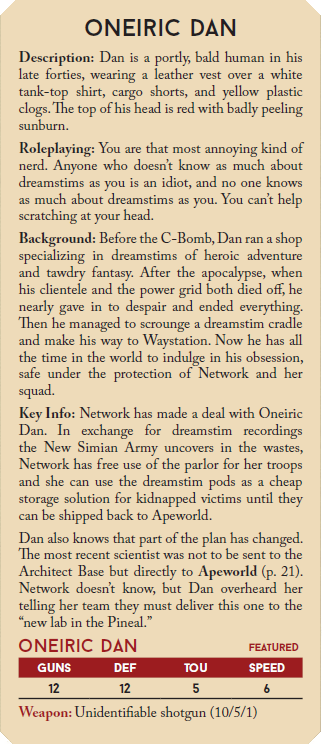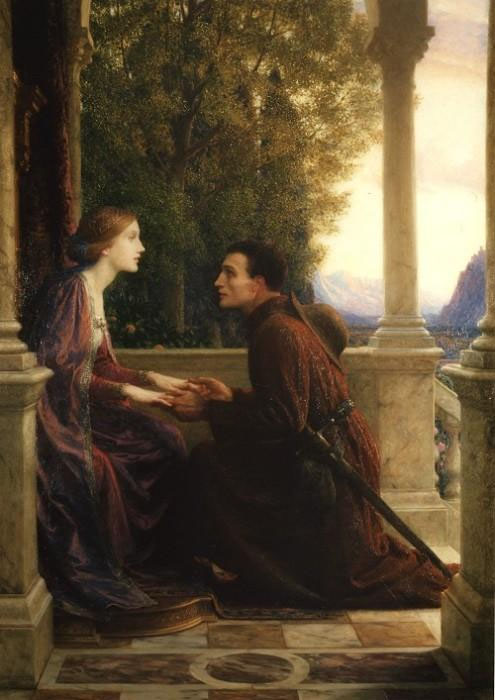
In 2015 I shared my Universal NPC Roleplaying Template, which is designed to structure the description of NPCs so that they can be quickly picked up and played at the table while simplifying the prep you do for them.
More bang for your buck, in other words.
The template is designed to be used with any system: I’ve used it in adventures for D&D, Numenera, Eclipse Phase, Trail of Cthulhu, Ars Magica, The Strange, Star Wars… The list goes on. I also implemented the template when I was the lead developer on Modiphius’ Infinity and, as the RPG Producer at Atlas Games, we now use it across most of our titles, notably to date in Over the Edge and Feng Shui.
Since posting the template, my use of it in development and at my personal table has seen further refinements to the system. I’ve also had a number of people contact me with either questions or suggestions. I thought this might be a good time to revisit the template with some advanced tips and tricks that you might find useful in enhancing your use of it.
BRIEFING SHEETS
The first thing I’ll note is that, when I’m using the template, I often think of and use NPCs as briefing sheets: For my personal campaigns, I try to have one NPC per page. And will try very hard to keep them on just one page. That’s not always possible, but the benefits in being able to quickly access information during play are usually worth tightening the NPC up if it means  keeping them to that single page.
keeping them to that single page.
I say “page,” but I also try to keep it to just one sheet. (So the back of the page is usually blank, which – if the front of the page is rather full – can be a great place to keep notes for updating the NPC for future sessions.)
In addition to having easy, clear access to the information for an NPC I’m currently playing, when I’m setting up a scene this also allows me to “cast” the NPCs in it by simply grabbing the appropriate sheets.
I usually keep my campaign notes in a three-ring binder, so I can just pop these sheets out and lay them all out on the table behind my GM screen. I can swap between characters with just a flick of my eye.
Similarly, when running a scenario using my party-planning scenario structure, I can just pull all the guests’ briefing sheets and then quickly rifle through them, making it easy to constantly mix and remix the social situations the PCs are in.
For added utility, if there’s room on the page, I will always try to include a picture of the NPC at the top of the sheet. (Assuming I have one, of course.) This simple visual cue makes it infinitely easier to quickly find the NPC I’m looking for, particularly in large, complicated scenes.
In published books we have to compromise, but I will generally try to segregate the template from the main text (placing it in a box or sidebar). This also usually guarantees that an NPC’s description stays entirely on a single page in layout. (You can see an example of this from Paul Stefko’s Feng Shui: Apeworld on Fire! on the right. You’ll note that we also dropped the bullet points here for stylistic reasons.)
QUOTE NO MORE
The original Universal NPC Roleplaying Template included a section for a sample quote from the NPC (e.g., “Just give me time to think. There must be a way,” or, “You’re a goddamn crazy freak! A certifiable circus clown! Fuckin’ hell, man!”).
Truth be told, I don’t use these any more. Your mileage may vary, but I found they just weren’t providing reliable value, and they were almost always the first thing I’d cut when trying to reduce the size of a particular NPC write-up (e.g., to make it fit on a single page).
If it seems like it would be useful for a particular NPC – i.e., that the word choice and phrasing of the character is the best way to clearly communicate character to yourself – it can be dropped into the Roleplaying section as one of the bullet points.
ROLEPLAYING: NO REPETITION
A note I frequently give when looking at the Roleplaying section of the template is to avoid repetition.
I recommend having three separate bullet points in that section, and the key word there is “separate.” Too often I end up seeing the same idea expressed in two or three slightly different ways:
- He respects hard work when he sees it in others.
- He’s worked for years to make the Talon & Eagle the best tavern it can be.
- Hard work is how he finds solace from the death of his wife.
“Hard work is important to him” is clearly a crucial concept for this character, but it can almost certainly be more clearly (and usefully!) expressed as a single bullet point. (Which will also leave you with more space to explore other aspects of the character.)
One tip for avoiding this trap is to have each bullet point describe a completely distinct classification of things: values, physical mannerisms, ways of speaking, personality, etc. This is far from being a hard-and-fast rule, but it’s a useful tip if you’re struggling to flesh out a character. (I talk about this a bit more in Random GM Tip: Memorable NPCs.)
BACKGROUND BOLD
The Cool Mama used the Universal NPC Roleplaying Template on her website and introduced the idea of using bold text to call out key concepts in the Background section. This is really smart and makes it even easier to pick up your NPC briefing sheet and almost instantly re-familiarize yourself with the character.
For example, you can take this character background:
Bhaltair is Ariadnan of Caledonian stock. When he was just a young kid, his father went off to fight in a bloody frontier conflict between Caledonia and Rodina. He never came back. Bhaltair made a pledge that he would work to never see his homeworld torn apart by such senseless violence again. He became a politician and quickly discovered how difficult the dream of peace can be. When the Human Sphere returned to Ariadna, he was at first overjoyed at how it unified the planet…and then watched in horror as the Commercial Conflicts ripped his planet apart again. He lost himself in drink for a time and then, concluding that the only way to bring true peace to Ariadna was to solve the off-planet problems that were manifesting themselves there, he became a diplomat. He did not participate in the negotiation of the Tohaa Contact Treaty, but he has recently arrived to take part in the Alliance Summit.
And greatly enhance it with some key bold:
Bhaltair is Ariadnan of Caledonian stock. When he was just a young kid, his father went off to fight in a bloody frontier conflict between Caledonia and Rodina. He never came back. Bhaltair made a pledge that he would work to never see his homeworld torn apart by such senseless violence again. He became a politician and quickly discovered how difficult the dream of peace can be. When the Human Sphere returned to Ariadna, he was at first overjoyed at how it unified the planet…and then watched in horror as the Commercial Conflicts ripped his planet apart again. He lost himself in drink for a time and then, concluding that the only way to bring true peace to Ariadna was to solve the off-planet problems that were manifesting themselves there, he became a diplomat. He did not participate in the negotiation of the Tohaa Contact Treaty, but he has recently arrived to take part in the Alliance Summit.
Knowing that you want to call out key concepts in bold, you can also write to make those most effective. For example:
Bhaltair is Ariadnan of Caledonian stock. During the frontier conflict between Caledonia and Rodina, his father fought in the war and never came back. Bhaltair made a pledge that he would work to never see his homeworld torn apart by such senseless violence again.
The slight rewrite there allows for a much tighter and actually more comprehensive bold key point.
EXPANDED KEY INFO
The Key Info section of the template is frequently misunderstood: This is not where you put important information ABOUT the character. That’s what the Background section is for. The Key Info section contains the essential details about whatever the character’s structural function in the current adventure is.
For example, if it’s a mystery scenario then you would probably list the clues that this NPC can give to the PCs. If the NPC is a noble the PCs are approaching to join their alliance against the White Hand, then the Key Info section would probably describe their reaction to that request (what they might want in exchange, what aid they’re capable of giving, suggestions they might make for other potential allies, etc.). If it’s a heist scenario, then it might be the score, information, or resources they can offer to support the heist (and what they want for it). And so forth.
Usually, the Key Info section should be short and straight to the point. Its whole function is, in fact, to pull these essential details out to make sure that you don’t overlook them during play. The longer and less focused the section becomes, the more likely you are to overlook stuff even when it’s listed as Key Info.
Some NPCs, though, are natural nexuses for lengthy Key Info sections: Either they’re crucially positioned to serve a lot of different functions, or the information they have to share is complicated or very detailed.
In those situations, what I’ve found useful is to actually use multiple Key Info sections.
These might be distinguished by a specific function. For example, if an NPC who has clues for solving a mystery is attending a party, I might include both:
- Key Info – Clues
- Key Info – Topics of Conversation
With the former, obviously, listing all of the clues, while the latter has any notes pertaining to the various topics of conversation being bandied about at the party.
In some cases, you may also find it useful to create multiple Key Info sections by topic. For example, an NPC might have some information on the werewolf sightings and also a lengthy account of the Haunting of Greybear Mansion, and thus:
- Key Info
- Key Info – Werewolf Sightings
- Key Info – Greybear Mansion
I’ll note that you should try to avoid doing this capriciously. Just because you break up one NPC’s lengthy Key Info section by topic, it doesn’t mean that every other NPC needs to have the section broken up in the same way (or at all). Most of the time, a single Key Info section with a couple bullet points is all you need.
UNTESTED: ADVANCED KEY INFO
These Key Info section types are things I’ve been experimenting with, but which have not yet been put through rigorous testing at the table. They may prove useful or they might turn out to be pure bupkis. (If you use them, let us know how it goes!)
KEY INFO – REACTIONS: This special Key Info section lists an NPC’s reactions to specific prompts from the PCs. This section can be a little tricky in actual practice, because it can be real easy to fall into contingency planning here. (If the PCs say A, then the NPC will do X. If they PCs say B, then the NPC will say Y. And so forth.)
I think the key here is to think of the section as being stuff that gets “unlocked” in response to specific stimuli. One example would be what the GUMSHOE system refers to as a leveraged clue: Just talking to someone will never elicit a particular piece of information. You first have to ask exactly the right question (which is usually predicated on learning a revelation elsewhere
But you can also imagine a similar rationale being applied to non-clue information. For example, in some cases the Topics of Conversation category I mentioned earlier for party scenarios might, in some cases, be interpreted as being of this type: The NPC will only offer their opinion about X if it comes up in conversation.
KEY INFO – ACTIONS: This section is for proactive social gambits that the NPC might attempt. I’ve always tried to play my NPCs proactively, but the presentation of the Universal NPC Template can often lend itself to a reactive presentation — it lists what the NPC knows, with the implicit assumption that the PCs will need to do something to extract that information.
Particularly in published material, there’s frequently a need to communicate clearly what courses of action the NPC will actively pursue in a social situation. For example:
- Carefully question the PCs regarding Old Man Rigger.
- Try to arrange a marriage between Fiona and their eldest son, Frederick.
- Slip a nano-tracker into a PC’s drink.
One thing I’m playing with here is the line between the NPC’s general goals (which I think probably fit better in either the Roleplaying or Background sections of the template) and these types of specific action (i.e. “this is a thing you, as the GM, should make sure this character does during this conversation”).
Design Note: Neither the Reactions nor Actions sections are meant to be comprehensive. They’re for keying very specific content that is essential to the structure of the scenario. It’s unlikely that they will be needed for every NPC. Most of the time you’ll be better off actively playing the NPC and discovering their actions and reactions in the moment.
KEY INFO – RESOURCES: This section would list any resources that the NPC has available to them. These might be resources that they can offer to aid the PCs (I’ve frequently included this sort of thing in the Key Info section without specifically calling it out). Or they might be resources they’ll employ to some other purpose.
Several of these tools were inspired by DragnaCarta’s social encounter stat block.
UNTESTED: SOCIAL PROFILE
This is another experimental tool, but the Social Profile would be an entirely new section of the roleplaying template.
An NPC’s Social Profile summarizes what social tactics may be particularly effective and/or ineffective when interacting with them. When used in conjunction with D&D 5th Edition, I think this could be cleanly keyed to the mechanical hook of advantage/disadvantage on subsequent social checks:
- Advantage: Complimenting Frederick on his clothing or sense of fashion.
- Advantage: Anyone signaling their sympathy for the White Hand.
- Disadvantage: Offering a bribe.
Something to potentially think about is how the PCs might learn or be cued into this information. (It might involve research or perhaps Wisdom (Insight) checks. See Rulings in Practice: Social Skills for some additional discussions along these lines.)
It’s possible that the Social Profile should actually be folded into the Key Info – Reactions section (i.e., someone complimenting Frederick’s sense of fashion causes him to react favorably), but at least for the moment I see a clear and distinct utility for the Social Profile.
Once again, I’m not sure the Social Profile is something that needs to be done for every single NPC. (Although maybe so if it got hooked into a wider social resolution structure in which the PCs were expected to investigate the NPCs they’re socially interacting with to figure out how to approach them. In that case the Social Profile would be kind of like Armor Class for social encounters.) But significant, central figures in a scenario, particularly those the PCs are likely to need to negotiate with or need to sway one way or another in their opinions, would almost certainly benefit.
Go to Part 2: Activity Logs





 Have you ever been running a published adventure, had the PCs encounter an NPC, and discovered that the NPC’s description was eight paragraphs of undifferentiated text? You remember reading through this stuff two days ago when you were reviewing the adventure, but how are you going to fish out all the little details from that wall of text? (And three scenes later, of course, you realize that everything has spun completely out of control because you forgot that the NPC was supposed to tell the PCs about the properties of the Starstone, but that was hidden away as a single sentence in the fourth paragraph. Whoops.)
Have you ever been running a published adventure, had the PCs encounter an NPC, and discovered that the NPC’s description was eight paragraphs of undifferentiated text? You remember reading through this stuff two days ago when you were reviewing the adventure, but how are you going to fish out all the little details from that wall of text? (And three scenes later, of course, you realize that everything has spun completely out of control because you forgot that the NPC was supposed to tell the PCs about the properties of the Starstone, but that was hidden away as a single sentence in the fourth paragraph. Whoops.)









